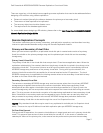
Dell PowerVault MD3600f/MD3620f Remote Replication Functional Guide
Page 4
virtual disk to a primary role. Hosts will then be able to read and write to the newly promoted virtual
disk and business operations can continue.
Replication Repository
A replication repository is a special virtual disk in the storage array created as a resource for the
primary MD36X0f storage array whenever Remote Replication is used. The MD36X0f stores
replication information in this repository, including information about remote writes that are not yet
complete. The MD36X0f uses this information to recover from controller resets, temporary network
outages, and accidental powering-down of arrays. When you activate the Remote Replication
premium feature on the array, two replication repository virtual disks are created, one for each
controller in the MD36X0f. An individual replication repository virtual disk is not needed for each
replication pair. When you create the replication repository virtual disks, you specify the location of
the virtual disks. Either you can use existing free capacity, or you can create a disk group for the virtual
disks from unconfigured capacity and then specify the RAID level.
Because of the critical nature of the data being stored, the RAID level of replication repository virtual
disks cannot be RAID 0 (for data striping). The required size of each virtual disk is 128 MB, or 256 MB
total for both replication repository virtual disks of a dual controller storage array.
Replication Relationships
Prior to creating a replication relationship, the Remote Replication premium feature must be enabled
and activated on both the primary and secondary storage arrays. The Remote Replication premium
feature enables the creation of up to 16 virtual disks in a replication relationship with virtual disks in
other Remote Replication enabled MD36X0f arrays. Each virtual disk within the array is replicated in a
1:1 relationship with its corresponding virtual disk and can be either in a primary or secondary role.
The following steps outline the creation of a remote relationship.
1. For use as secondary virtual disks, virtual disks on the secondary storage array must be created on
the secondary site if they do not already exist and secondary virtual disk must be a standard virtual
disk.
2. The secondary virtual disk candidates must be configured with equal or greater capacity than the
associated primary virtual disk.
3. Secondary virtual disk candidates may be of different RAID configurations – it is not required to
have the same RAID configuration for both virtual disks in a replicated pair relationship. But, the
available capacity must meet the step 2 requirements.
4. When secondary virtual disk candidates are available, a replication relationship can be established
in the storage management software (MDSM) by identifying the array containing the primary virtual
disk and the array containing the secondary virtual disk, then choosing the specific virtual disk as
the secondary virtual disk.
5. The replication relationships can be any of the replication relationships defined in Figure 1.

















